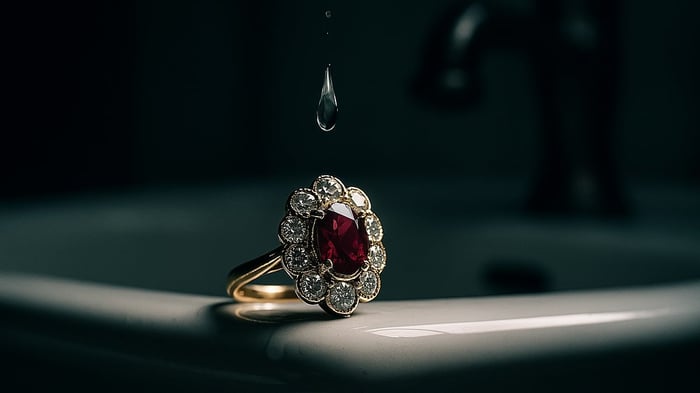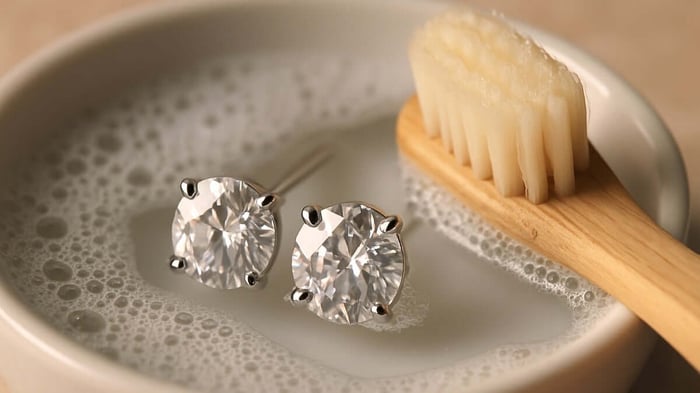Table of Contents
Confession time: The first time I stood in front of a jewellery shop window, dazzled by all that irresistible sparkle, I barely noticed the price tags. I was fixated on the gleam, daydreaming of proposals on windswept cliffs or adding a hint of opulence to an ordinary Thursday. I entered the store, looked at some earrings, then a jeweller asked, "Do you want to see the GIA grading report?"—and, quite frankly, I hadn't a clue what about GIA diamond grading. If that sounds familiar, you’re not alone.
Diamonds may be forever, but let’s face it: buying one can feel as mysterious as joining a secret society. Fear not—this post lifts the velvet rope, inviting you inside the fascinating (and refreshingly logical) world of GIA grading. It’s time to see that diamond for what it really is: more than a sparkle.
TL;DR: Diamonds are graded by GIA using the ‘Four C's’—colour, clarity, cut, and carat weight—providing buyers with scientific assurance of quality. This guide unpacks these grading secrets and offers practical tips for buying in 2025.
The GIA Grading System: More Than Just Glitter
When it comes to diamonds, beauty is only the beginning. The GIA diamond grading system stands as the global benchmark for evaluating diamond quality, offering more than just a surface-level sparkle. Established in 1931, the Gemological Institute of America (GIA) revolutionised the industry by introducing a universal language for diamond assessment. This system, rooted in scientific rigour and objectivity, ensures that every diamond is evaluated fairly—no matter where it comes from.
Certified Twist Oval Diamond Halo Engagement Ring 0.85ct E/VS in Platinum

$2,679.00
$4,798.00
Showcasing an exquisite twist design, this platinum engagement ring centres around a 0.50ct oval diamond, paired with 0.35ct of E/VS quality halo and side stones, totalling 0.85ct. With the promise of UK craftsmanship and a lifetime workmanship guarantee, this lovely… read more
Origins of Trust: The GIA’s Global Language
Before the GIA, there was no standard way to describe a diamond’s quality. GIA’s introduction of the Four C’s—colour, clarity, cut, and carat weight—changed everything. As the GIA states,
“The key to understanding a diamond and its value is to understand the four attributes that all diamonds share: colour, clarity, cut, and carat weight.”
This language is now spoken worldwide, giving both buyers and sellers a clear, consistent way to discuss and trust diamond quality.
Scientific Precision and Objectivity
Every diamond entering the GIA laboratory is subject to a meticulous process. Diamonds are graded under tightly controlled lighting and viewing conditions, and each stone travels through the lab in a nondescript case. This anonymity ensures that grading is unbiased and consistent. Expert gemologists use advanced technology and established protocols to assess each diamond’s unique characteristics, resulting in a transparent and reliable GIA grading report.
Natural vs Lab-Grown Diamonds: Confirming Authenticity
A critical first step in the GIA diamond grading system is determining whether a diamond is natural or lab-grown. Every diamond is scientifically tested to confirm its origin before the Four C’s are even considered. If a diamond is found to be synthetic, it is routed through a separate grading and reporting process. This ensures that buyers receive honest representation and clarity regarding diamond authenticity and treatment.
Fact | Detail |
|---|---|
GIA Founded | 1931 |
Grading Conditions | Controlled lighting & anonymous cases |
Institute Size | Largest gemological institute worldwide |
The GIA diamond grading report is recognised as the industry’s most robust assurance, providing buyers with the confidence that their diamond’s quality and authenticity have been evaluated with the utmost integrity.
💎 Ready to put the Four C’s into practice? Explore natural diamond jewellery at AllDiamond.co.uk
Cracking the Code: The Four C's of Diamonds
Understanding the Four C's of diamonds—Colour, Clarity, Cut, and Carat weight—is essential for anyone seeking to appreciate what makes each stone unique. The Gemological Institute of America (GIA) developed rigorous grading systems for each C, ensuring diamonds are evaluated with scientific precision and consistency.
Colour: Less is More
Diamond colour grading is all about absence. The GIA colour scale runs from D (completely colourless) to Z (light yellow or brown). Diamonds graded D are exceptionally rare and highly valued, while those closer to Z show increasing tint. At the GIA lab, each diamond is compared against a master set to determine its place on the colour grading scale. It’s worth noting that colour becomes more visible as carat weight increases, making high-grade large diamonds especially prized.
Clarity: Nature’s Fingerprint
The diamond clarity scale reflects the presence of internal inclusions and external blemishes. GIA’s clarity grades span 11 steps, from Flawless (no inclusions visible at 10x magnification) to Included (I3), where inclusions are obvious to the naked eye. Each diamond’s unique pattern of inclusions is plotted, serving as a natural fingerprint. Graders also check for any treatments that might artificially improve clarity, ensuring transparency and authenticity.
Cut: Beyond Shape
Many assume cut refers only to shape, such as round or square. In reality, diamond cut quality is far more complex. As the GIA notes,
You may think of cut as the shape of a diamond like square cut or round. However, there is much more to cut than the basic shape. How a diamond is cut and polished directly affects the amount of sparkle and brilliance that comes off the stone.
The GIA cut grade assessment for round brilliant diamonds ranges from Excellent to Poor, based on hundreds of measurements—angles, facet proportions, symmetry, polish, and more—captured by advanced optical devices. The result: a cut grade that directly influences a diamond’s fire, brilliance, and scintillation.
Carat Weight: Precision Matters
Carat weight diamonds are measured with extraordinary accuracy. One carat equals 200 milligrams, and GIA’s electronic microbalances record weight to the fifth decimal place. However, size alone does not dictate value or beauty. Clever settings, such as illusion settings, can make smaller diamonds appear larger, proving that carat is just one part of the equation.
Certified Diamond Solitaire Engagement Ring 0.25ct E/VS Quality 18k Yellow Gold

$991.00
$1,482.00
The sleek design and magnificence of this engagement ring are sure to delight the special person in your life and give the perfect heart-warming glow when you place it on her finger. This exquisite ring features a 0.25ct and E/VS… read more
A Diamond’s Passport: Making Sense of the GIA Grading Report
When considering a diamond purchase, the GIA diamond grading report is far more than a simple certificate—it is the diamond’s unique passport. This document offers a comprehensive, scientific analysis of the stone, providing buyers with confidence and clarity about their investment. As the Gemological Institute of America states,
“A GIA report is the most technologically advanced diamond evaluation possible. It provides a unique blueprint of a diamond's attributes and a permanent record of its quality.”
What Makes the GIA Grading Report So Important?
The importance of a GIA report lies in its detail and reliability. Each report is recognised worldwide and serves as a permanent record of the diamond’s quality and origin. Unlike standard certificates, a GIA grading report includes a wealth of additional information, ensuring that buyers are fully informed about their diamond’s characteristics and value.
Features of the GIA Grading Report
The Four C’s: Every report covers colour, clarity, cut, and carat weight, the essential factors in diamond evaluation.
Beyond the Basics: Expect to find details on symmetry, polish, proportions, and an identification plot—a diagram mapping internal and external features.
Diamond Clarity Grades: The report explains the clarity grade, helping buyers understand inclusions and blemishes.
Diamond Authenticity Treatment: Any treatments or enhancements are clearly disclosed, protecting buyers from misrepresented stones and ensuring value retention.
Laser Micro-Inscription: For added security, many GIA-graded diamonds are microscopically inscribed along the girdle with their unique report number—visible only with magnification, offering reassurance and traceability.
How to Use the GIA Grading Report
The GIA diamond grading report is designed to be user-friendly. Each section is clearly labelled, allowing buyers to verify the diamond’s specifications and authenticity at a glance. The GIA Retailer Lookup tool also enables buyers to confirm the credentials of participating jewellers, adding another layer of trust to the buying process.
Why Diamond Certification Matters
A GIA diamond grading report is not just a formality—it is your assurance of the diamond’s authenticity and quality. It helps distinguish natural diamonds from those that have been treated or enhanced, and it is an essential tool for comparing stones and understanding pricing. It is a good idea to request a diamond certified by the GIA or a similarly reputable grading lab to ensure your investment is protected and its value is preserved.
Diamond 0.10ct G/SI Lightning Stud Earrings in 9k White Gold

$350.00
$547.00
Impressive and fashion-forward, these earrings will leave you looking forward to wearing them. Made from 9K White Gold, this beautiful pair of diamond stud earrings feature a lightning bolt design that is sure to catch the eye of everyone who… read more
From Dazzle to Decision: The Human Side of Diamond Buying
The journey from admiring a diamond’s sparkle to making a confident purchase is as much about emotion as it is about expertise. The process of choosing diamonds and diamond jewellery should be “exciting and enjoyable. Just keep all the four C’s in mind.” Yet, beyond the technicalities of colour, clarity, cut, and carat weight, lies a deeply personal experience that no checklist can fully capture.
Consider the moment of choosing between a ‘Good’ and ‘Excellent’ cut stone. For many, this decision is not simply about the numbers on a GIA report or the advice of a Diamond buying checklist. It’s about the unexpected emotional connection—a subtle spark that draws you in. Sometimes, the heart knows best, and that connection can outweigh the pursuit of technical perfection. This is the human side of diamond buying, where logic and feeling intertwine.
Many myths persist in the world of diamonds. One of the most common is that bigger is always better. In reality, clever settings—such as halo or bezel designs—can make smaller stones appear larger and more impressive. Similarly, not all lower grades are the poor relations of the diamond world. A well-cut diamond with slightly lower clarity or colour can still deliver breathtaking brilliance, especially when paired with a setting that complements its strengths. Shape and setting can dramatically alter a diamond’s perceived size and colour, sometimes more so than the Four C’s alone.
Imagine, for a moment, a world where every diamond was identical—flawless, perfectly cut, and indistinguishable from one another. Would the magic remain? Or is it the subtle differences, the quirks and character, that make each diamond—and each buying experience—so memorable? The drama and delight of diamond buying come from these unique choices and the stories they create.
Practicality, however, must never be overlooked. Unless the diamond is very small, always ask for a diamond grading report. If a jeweller cannot or will not provide one, it is wise to walk away, regardless of how charming their sales pitch may be. The GIA Retailer Lookup tool is an invaluable resource for finding trustworthy, GIA-trained jewellers, ensuring your purchase is as secure as it is special.
In conclusion, the modern diamond buying experience is about more than just sparkle. It is a balance of emotion, budget, expert guidance, and personal style. By embracing both the science and the sentiment, buyers can make informed, joyful decisions—ensuring their chosen diamond truly shines in every sense.
Black Diamond Full Eternity Ring 0.35ct 50 Stone in 18k White Gold

$746.00
$1,001.00
This eternity ring has an elegant and timeless beauty. Handcrafted in immaculate 18k white gold, this ring showcases a full circle of round-cut natural black diamonds of G/SI quality with a total weight of 0.35ct. The black diamonds are mounted… read more
Shop Diamond Jewellery with Confidence
Understanding GIA diamond grading takes the mystery out of buying. At AllDiamond.co.uk, every piece of natural diamond jewellery is crafted with British expertise, backed by certifications from the GIA and others, where applicable, and protected by our lifetime workmanship guaranteBrowse Natural Diamond Jewellery Today




